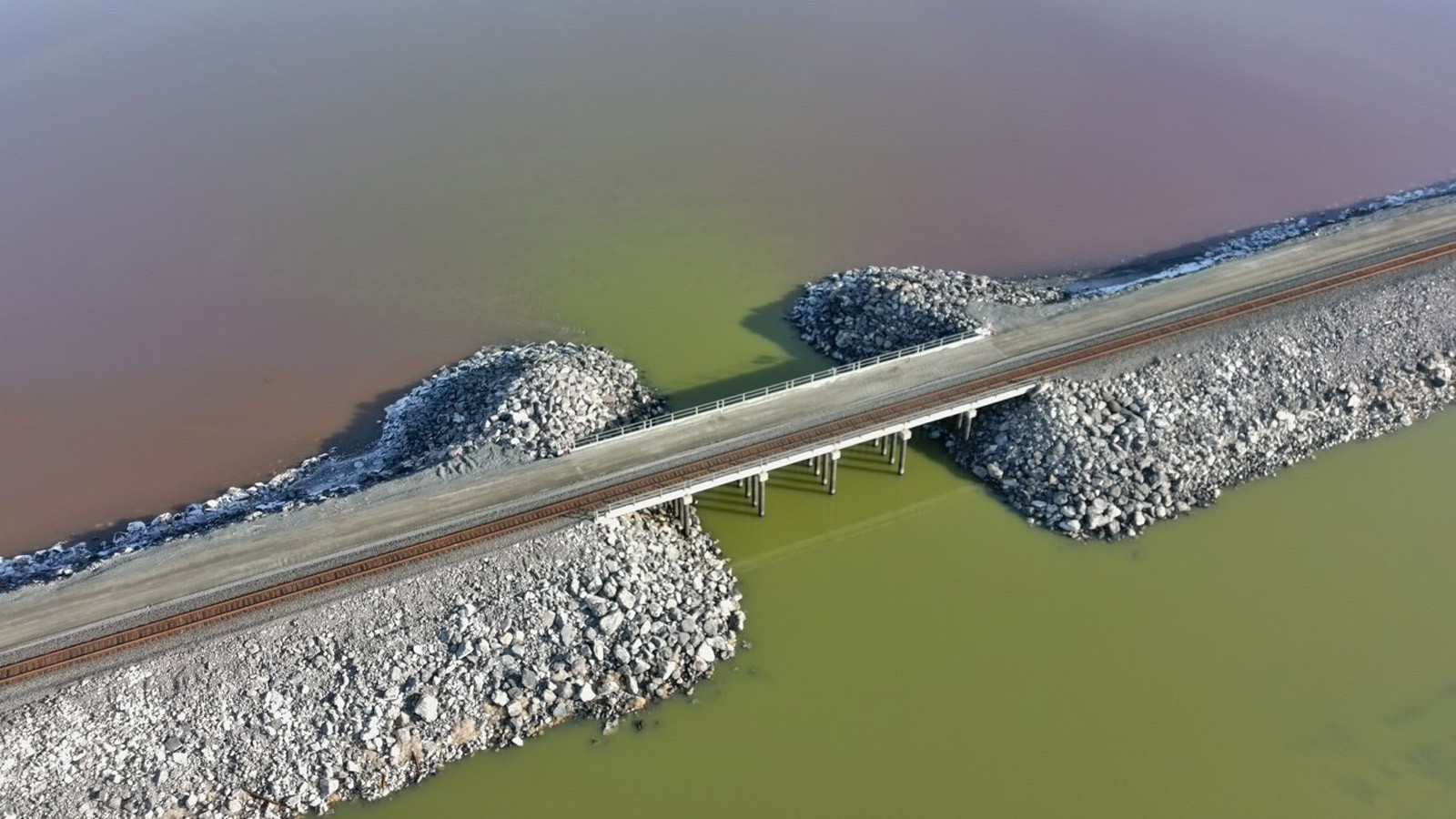Great Salt Lake Berm Modification Informed by USU Research
Utah Water Research Laboratory, College of Engineering Modeled, Tested Fix to Rebalance Saline Levels Amid Drought
By Micah Safsten |
An aerial photo shows the West Crack Breach in the Great Salt Lake's railroad causeway. USU researchers modeled and tested a modification to the berm here to rebalance salinity in separate portions of the lake amid drought conditions. (Photo Credit: USU/Som Dutta and Brian Crookston)
A railroad causeway divides the waters in the Great Salt Lake except for a small opening known as the West Crack Breach. The State of Utah recently funded researchers at the Utah Water Research Laboratory and College of Engineering at Utah State University to study flows through this opening as an avenue for mitigating certain effects of the ongoing drought.
Flows through this breach are complex and difficult to measure and predict, but these flows influence salt concentrations on both sides of the causeway, which is of high interest not only to the state but also to the mineral and brine shrimp industries. In the last year, continued drought has increased salt concentration of the southern portion to a critical level, mandating the modification of the berm at the breach.
As the Utah Department of Natural Resources considered its options, it asked assistant professors Som Dutta, of the Department of Mechanical and Aerospace Engineering, and Brian Crookston, of the Utah Water Research Laboratory and Department of Civil and Environmental Engineering, to study the effects of raising this breach and to model various berm heights. Graduate students Holland Kartchner and Michael Rasmussen assisted in creating and running the computational fluid dynamics model used for the analysis.
“We tested various scenarios,” Dutta says, “and reported to Utah DNR the effect of 2-, 4- and 6-foot increases in berm height.”
After considering these various height increases, Utah DNR chose to increase the breach in the berm by about 4 feet with construction completed this past July. The modified berm now limits the amount of high-saline water that pours into the southern arm.
Early indications are that the 4-foot increase was an appropriate measure.
“Based on the recent measurements at the breach, our analysis was correct,” Dutta says.
Eric Dixon, design and construction section manager at the Utah Division of Water Resources, agrees. He told KSL last week: “Initial readings indicate that the completed work is significantly reducing the flows of the higher salinity waters through the bottom of the channel.”
The Utah Water Research Laboratory is a water and environmental research facility at USU. Much of its work informs practical policy and management solutions, and its faculty, staff and students conduct research to advise decisionmakers on pressing water-related issues in the State of Utah and beyond.
That includes the berm across the Great Salt Lake: “We will continue to work in the field with the U.S. Geological Survey and with our models, as the Utah DNR considers the berm an adaptable structure, so they likely will make changes to it in the near future based upon field conditions,” Crookston says.
WRITER
Micah Safsten
Communications & Outreach Coordinator
Utah Water Research Laboratory
435-797-0735
micah.safsten@usu.edu
CONTACT
Som Dutta
Assistant Professor
Mechanical and Aerospace Engineering
som.dutta@usu.edu
Brian Crookston
Assistant Professor
Civil and Environmental Engineering/Utah Water Research Lab
brian.crookston@usu.edu
TOPICS
Engineering 336stories Water 257stories Climate 151stories Great Salt Lake 34storiesComments and questions regarding this article may be directed to the contact person listed on this page.







